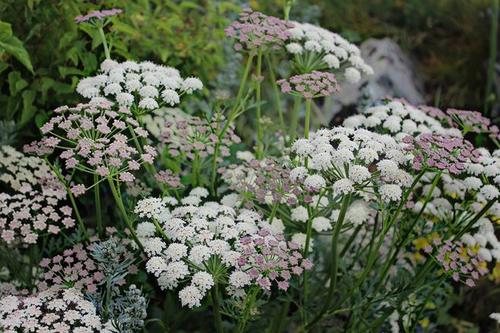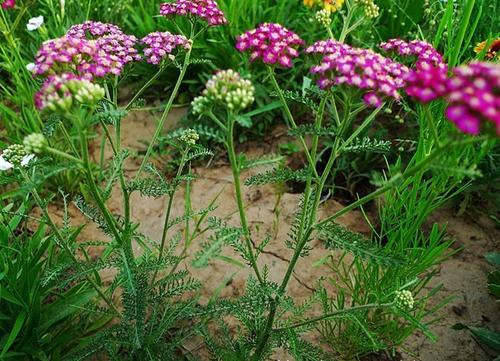Achillea millefolium (Yarrow) profile
Written by Maggie
Feb 24 2021

Yarrow, scientific name Achillea millefolium, is a perennial herb of Achillea in the composite family. Yarrow is often cultivated in gardens all over China, and is rare in Xinjiang, Inner Mongolia and Northeast China. The leaves and flowers contain aromatic oil, and the whole grass can also be used as medicine. It has the effect of sweating and driving wind.
Yarrow picture

Morphological features of the Yarrow
Stems
Yarrow is a perennial herb with thin creeping rhizomes. Stems are erect, 40-100 cm tall, pinstriped, usually white villous, distally branched or unbranched, often with shortened sterile branches in upper middle leaf axils.
Leaf
Yarrow leaves are sessile, lanceolate, moment cone lanceolate or nearly bar, 5-7 cm long, 1-1.5 cm wide, 2 to 3 feather back all crack, rachis 1.5 2 mm wide, lobes most once, 1.5 7 mm intervals, sometimes basal lobes between the upper part of the one in the middle, lobes lanceolate to at the end of the bar, 0.5 1.5 mm long, 0.3 0.5 mm wide, apex with short RuanGuZhi pointed, the glands, densely sunken into the above how much coat, here is the secret of v long pilose.Leaves of lower leaves and vegetative branches are 10-20 cm long and 1-2.5 cm wide.
Flowers
The head of Yarrow is numerous, dense into 2-6 cm in diameter complex cymbose; Involucral moments are orbicular or subovate, ca. 4 mm long, ca. 3 mm wide, sparsely pilose; Involucral bracts are 3-tiered, imbricate, elliptic to oblong, 1.5-3 mm long, 1-1.3 mm wide, back middle green, midrib raised, margin membranous, brown or yellowish; Stellar of Yarrow is moment oblong elliptic, membranous, abaxially scattered yellow shiny glandular spots, distally pubescent. Yarrow has 5 edge flowers; Tongue is suborbicular, white, pink or lavender red, 1.5-3 mm long, 2-2.5 mm wide, apex 2-3 toothed; Discoid bisexual, tubular, yellow, ca. 2.2-3 mm long, 5-dentate, glandular outside.
Fruit
Achene of Yarrow rounded, ca. 2 mm long, pale green, with narrow pale white side ribs, without coronal crowns.
Flowering season of Yarrow is from Summer to autumn.
The ecological habits of the Yarrow
Yarrow is hardy; Photophilic and slightly alkaline soils.
Yarrow prefers fertile, well-drained soil and a sunny environment.
Growing methods of Yarrow
Seeding method
Yarrow germination is suitable for the temperature of 15-20℃, spring and autumn can be divided into plants or sowing reproduction, sowing multi-row drill. Keep the soil moist and germinate for about a week.
Planting method
Seedling out of the same, appropriate thinning, seed germination ability can be maintained for 2-3 years, Yarrow propagation can be applied with compost or a small amount of oil meal as the base fertilizer, the growth is good.It is hardy, likes sandy loam with deep soil layer, good drainage and rich humus, and requires sufficient sunlight.
Maintenance method
Yarrow growth is suitable for temperature 5-25℃. When summer is hot and rainy, lower leaves often become yellow, should be pruned timely and pay attention to drainage.

Yarrow propagation methods
Yarrow propagation: dividing, cutting, sowing.
Cultivation record: Lime was used to adjust acid soil before planting. Avoid being too wet.
The Yarrow's distribution area
The Yarrow is native to the temperate regions of the Northern Hemisphere.
Yarrow is distributed in Mongolia, Iran, Europe, Russia, Africa and Northeast China, Inner Mongolia and Xinjiang. Yarrow grows at an altitude of 200 m to 2,300 m. It can be found in wet grasslands, wasteland and railway lines.
Yarrow main value
Medicinal value
Rheumatism bi pain, injuries, and blood stasis dysmenorrhea, swollen chuangdu, bleeding hemorrhoids.
The garden use of the Yarrow
Yarrows can be made in flower beds, pot planting, cut flowers, dried flowers.

Latest Updated
- Benefits of Bugleweed - 7 Science-backed Health Benefits
- Bugleweed Dangers & Side Effects - Is It Poisonous?
- How to Plant Evergreen Trees - What You Should Know
- When to Plant Evergreens - Grow Guide for Evergreen Trees
- 12 Wonderful Evergreen Shrubs for Your Garden
- 12 Popular Evergreen Plants with Pictures for Beginners
- When And How To Prune A Lilac Bush Like a Pro
- How to Grow & Care for Lilac Vine (Hardenbergia Violacea)
- Japanese Lilac Tree (Syringa Reticulata) Care & Propagation Guide
- Shumard Oak Pros and Cons - What to Know
Popular Articles
- Winter maintenance of Antirrhinum Majus
- How to Grow Terminalia Mantaly Tree
- How to Grow and Care for Crossostephium Chinense
- How to grow Antirrhinum Majus in spring
- Peristeria Elata (Dove Orchid) Profile: Info & Care Guide
- Underwatered Snake Plant (Sansevieria Trifasciata) - Signs And How To Fix
- How to Care for Brazilian Jasmine Plant (Mandevilla Sanderi)
- How to Grow & Care for Graptopetalum Purple Delight in Summer
- Rosa Chinensis (China Rose): Plant Growing & Care Tips
- How to Care for Baby Sun Rose (Aptenia Cordifolia)